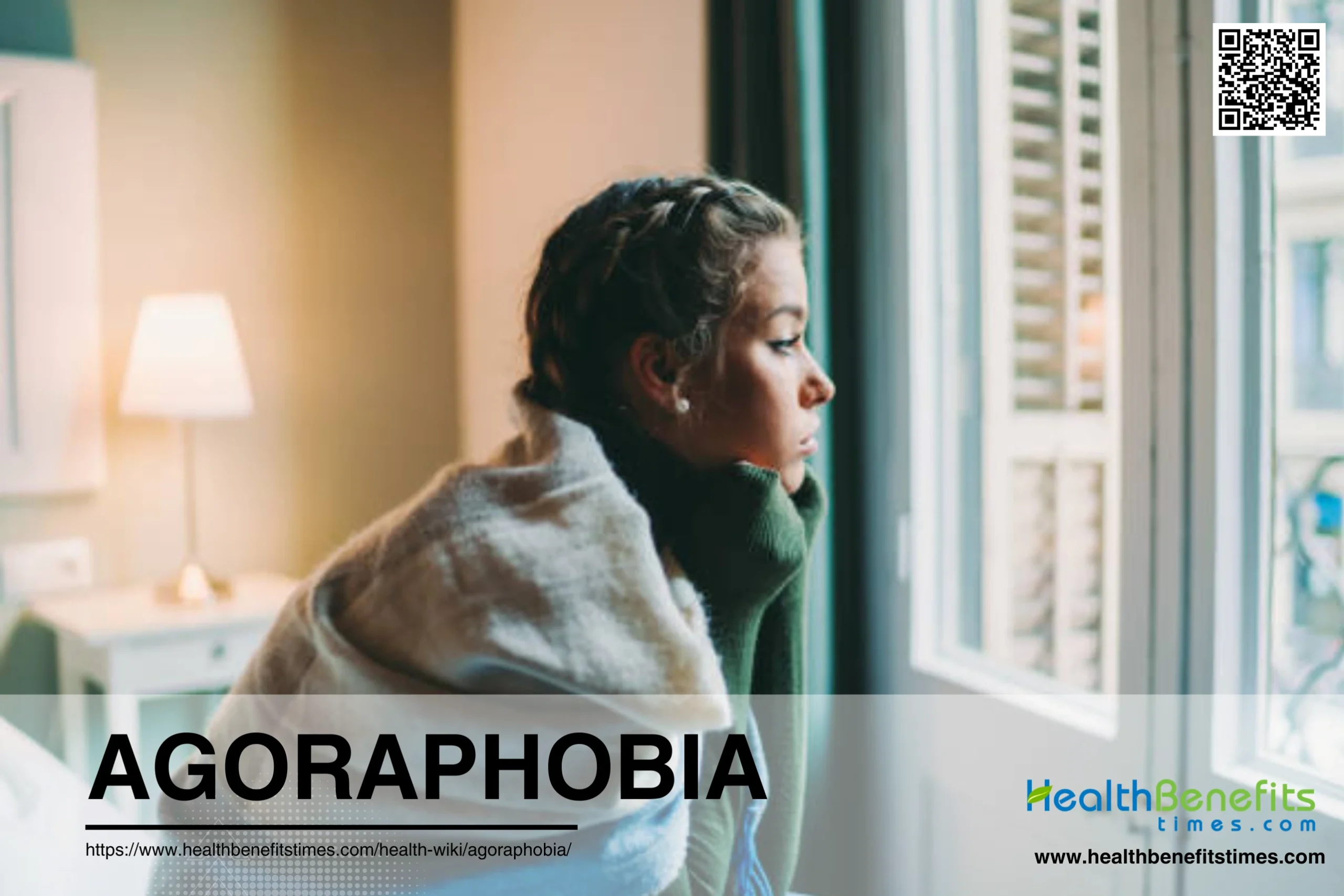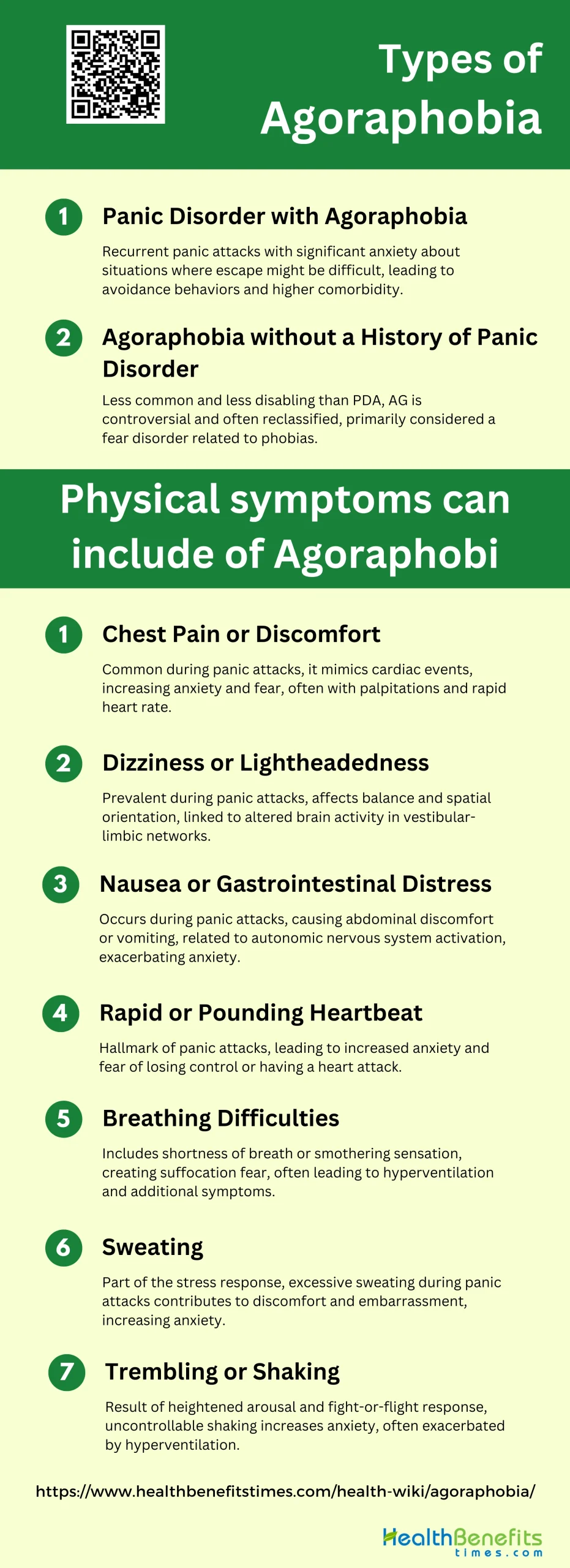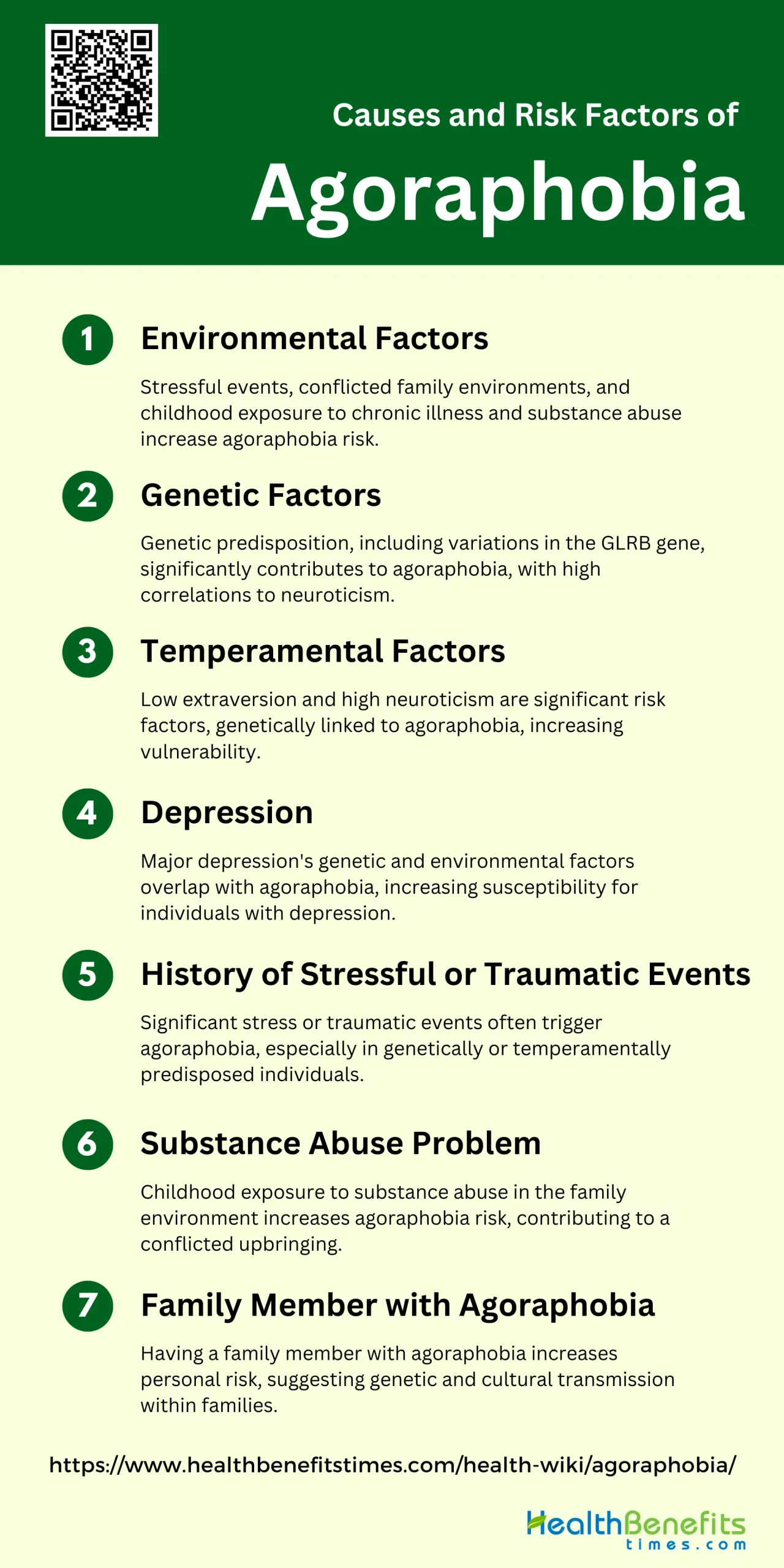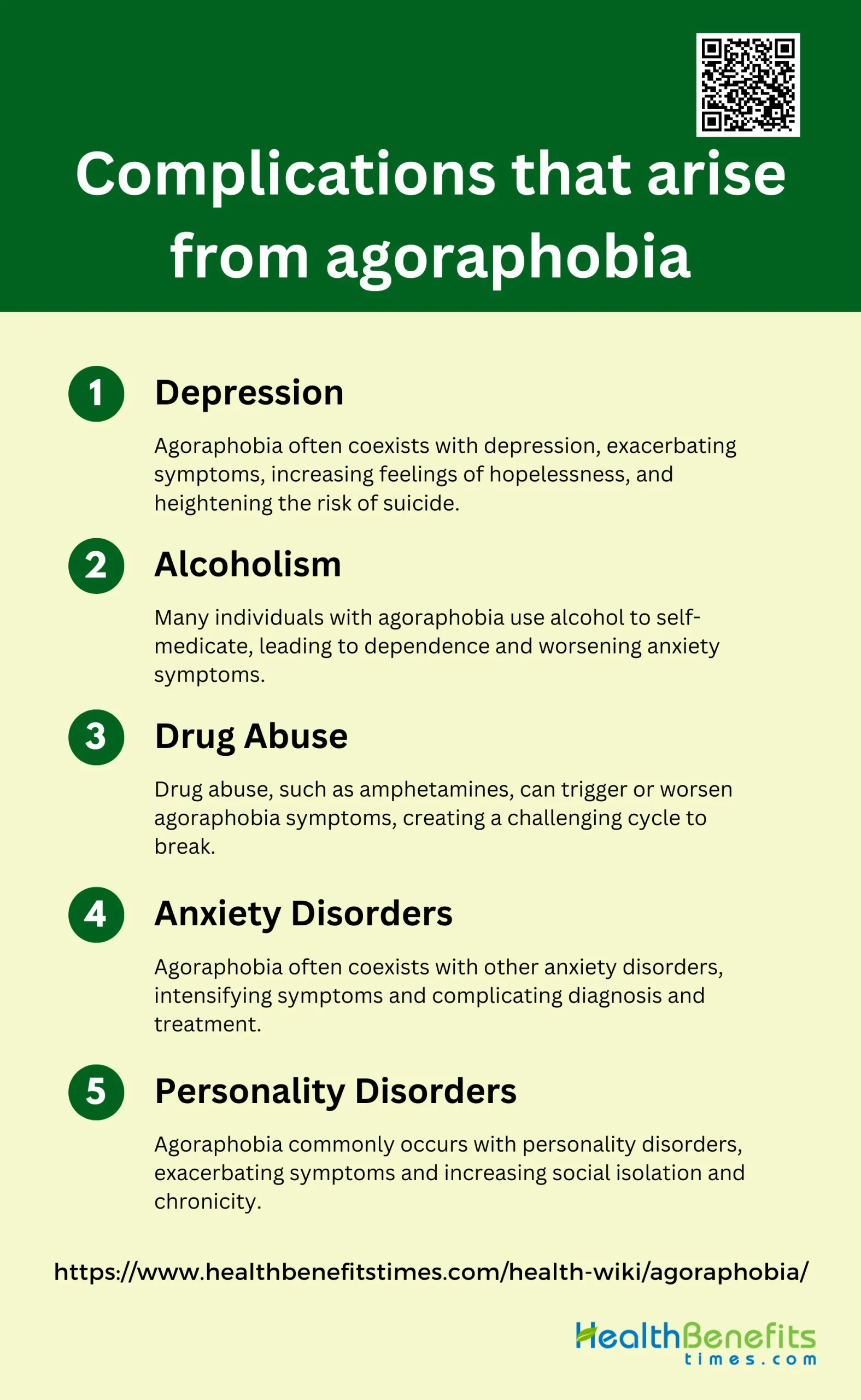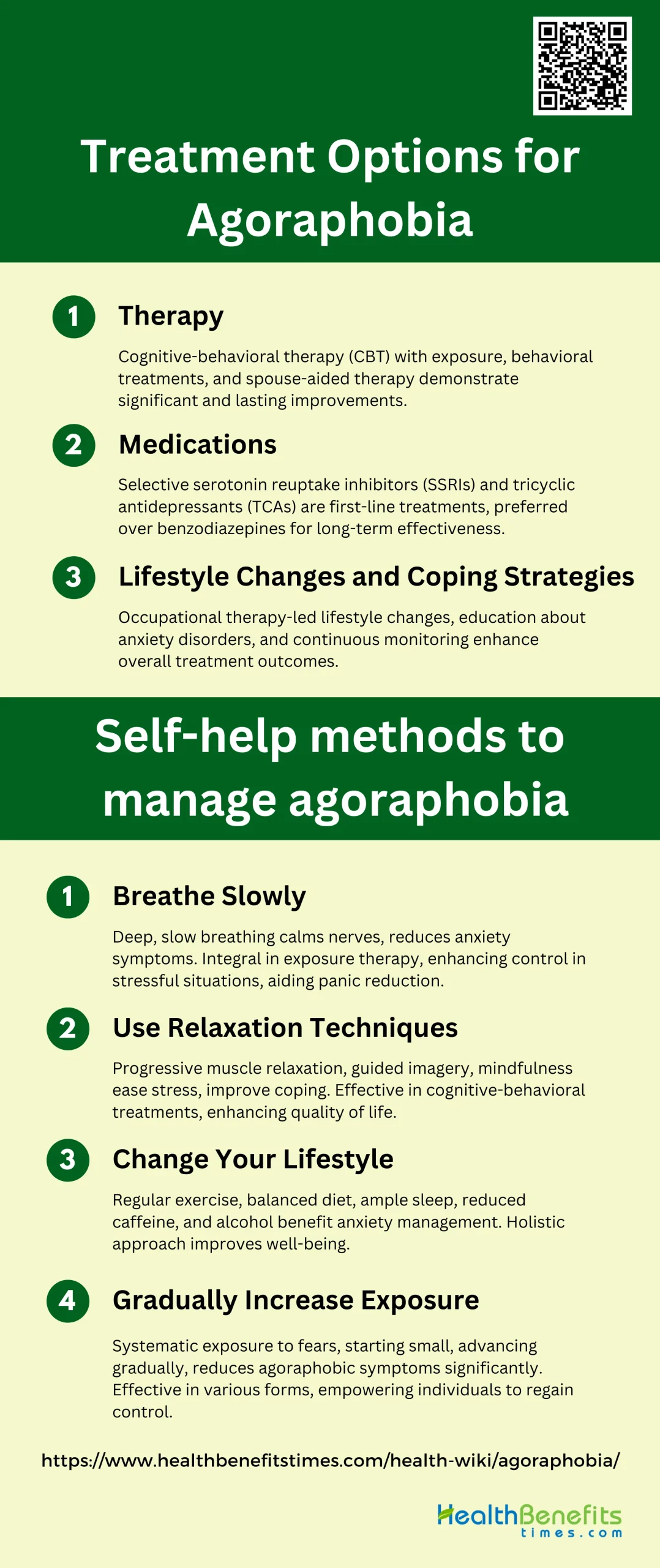Agoraphobia is an anxiety disorder characterized by an intense fear of situations where escape might be difficult or help unavailable, often leading to avoidance of such places. This fear can manifest in various settings, including public transportation, open or enclosed spaces, crowds, or simply being outside the home alone. Individuals with agoraphobia may experience severe anxiety or panic attacks in these situations, causing them to avoid them altogether, sometimes becoming housebound. The condition is often linked to panic disorder and can significantly impair daily functioning. Treatment typically involves cognitive behavioral therapy (CBT) and medications such as selective serotonin reuptake inhibitors (SSRIs) to manage symptoms and improve quality of life.
Types of Agoraphobia
From fear of open spaces to the dread of being in crowded places, the types of agoraphobia can significantly impact an individual’s ability to navigate daily life. Here are the different types of agoraphobia that individuals may experience:
1. Panic Disorder with Agoraphobia
Panic disorder with agoraphobia (PDA) is characterized by recurrent panic attacks accompanied by significant anxiety about being in situations where escape might be difficult or help unavailable during an attack. This condition often leads to avoidance behaviors, where individuals steer clear of places or situations that might trigger panic attacks. Research indicates that PDA is associated with higher levels of comorbidity, disability, and neuroticism compared to panic disorder (PD) or agoraphobia without panic disorder (AG). Cognitive factors such as anxiety sensitivity and catastrophic thinking about panic consequences are prevalent in PDA, although they do not significantly differentiate it from PD without agoraphobia. Additionally, PDA patients often report prodromal symptoms like generalized anxiety and hypochondriacal fears before the onset of panic attacks, suggesting that phobic avoidance may not always be secondary to panic attacks. The multivariate comorbidity patterns of PDA show it as a mixed distress and fear disorder, supporting its classification as a distinct diagnostic entity.
2. Agoraphobia without a History of Panic Disorder
Agoraphobia without a history of panic disorder (AG) is a controversial diagnosis, with some researchers arguing it is part of the panic disorder spectrum rather than a separate entity. Studies have shown that AG is less common and less disabling than PDA but still significant in terms of human suffering. Epidemiological data suggest that AG without panic attacks is rare, and many cases initially diagnosed as AG without panic were later reclassified as simple phobias or other anxiety disorders upon reappraisal. Cognitive-behavioral treatments are less frequently used for AG, and the course of the disorder tends to remain relatively unchanged over time. The relationship between AG and panic disorder remains inconclusive, with some studies suggesting that AG may share a continuum with panic disorder and PDA rather than being a distinct category. Multivariate analyses indicate that AG is primarily a fear disorder, closely related to phobias, supporting its independent classification in diagnostic systems.
Symptoms and Diagnosis of Agoraphobia
Characterized by an intense fear of being in situations where escape might be difficult or help wouldn’t be available, it often leads to avoidance behaviors that can disrupt daily life. Recognizing the symptoms is the first step toward diagnosis and management. Below is a list of common indicators and diagnostic approaches for agoraphobia.
- Being afraid of spending time alone
- Being afraid of places where escape might be hard
- Being afraid of losing control in a public place
- Depending on others
- Feeling detached or separated from others
- Feeling helpless
- Feeling that the body is not real
- Feeling that the environment is not real
- Having an unusual temper or agitation
- Staying in the house for long periods
Physical symptoms can include of Agoraphobia
A condition often associated with anxiety disorders, can manifest through a variety of physical symptoms that significantly impact daily functioning. These symptoms arise as the body’s response to fear and stress, typically occurring in environments where an individual feels trapped, helpless, or embarrassed. Below is a list of common physical symptoms that individuals with agoraphobia may experience.
1. Chest Pain or Discomfort
Chest pain or discomfort is a common symptom experienced by individuals with agoraphobia, often manifesting during panic attacks. This symptom can be particularly distressing as it mimics the sensations associated with cardiac events, leading to increased anxiety and fear. For instance, a case study of a collegiate basketball player revealed that exertional chest pain, coupled with dyspnea and dizziness, was ultimately attributed to panic attacks with mild agoraphobia after ruling out organic causes. The sensation of chest pain during a panic attack is typically accompanied by other symptoms such as palpitations and a rapid heart rate, which further exacerbate the individual’s fear and discomfort.
2. Dizziness or Lightheadedness
Dizziness or lightheadedness is another prevalent symptom in individuals with agoraphobia, often occurring during panic attacks. This symptom can be particularly debilitating as it affects the individual’s sense of balance and spatial orientation. Research has shown that individuals with subclinical agoraphobia exhibit lower functional connectivity in vestibular-limbic networks, which are crucial for processing visual space-motion information and controlling locomotion. This altered brain activity may contribute to the dizziness experienced during panic attacks. Additionally, historical descriptions of agoraphobia have highlighted dizziness as a central problem, often linked to disorders of the ocular muscles or vestibular system.
3. Nausea or Gastrointestinal Distress
Nausea or gastrointestinal distress is a common symptom reported by individuals with agoraphobia during panic attacks. This symptom can manifest as a feeling of abdominal discomfort, nausea, or even vomiting. The physiological response to anxiety and fear often involves the activation of the autonomic nervous system, which can lead to gastrointestinal disturbances. For example, a case report of a male client with panic anxiety and agoraphobia noted symptoms such as nausea and abdominal distress during panic attacks. These gastrointestinal symptoms can further exacerbate the individual’s anxiety, creating a vicious cycle of fear and physical discomfort.
4. Rapid or Pounding Heartbeat
A rapid or pounding heartbeat, also known as palpitations, is a hallmark symptom of panic attacks in individuals with agoraphobia. This symptom is often one of the first to appear during a panic attack and can be extremely distressing. Studies have shown that individuals with panic disorder, including those with agoraphobia, frequently experience palpitations and an accelerated heart rate during panic episodes. The sensation of a racing heart can lead to increased anxiety and fear of losing control or having a heart attack, further intensifying the panic attack. Effective management of this symptom often involves psychological therapies such as cognitive-behavioral therapy (CBT), which has been shown to reduce the frequency and intensity of panic attacks.
5. Breathing Difficulties
Breathing difficulties, including sensations of shortness of breath or smothering, are common symptoms experienced by individuals with agoraphobia during panic attacks. These symptoms can create a sense of suffocation and exacerbate the individual’s fear and anxiety. Research has indicated that individuals with panic disorder and agoraphobia often report breathlessness as a prominent symptom during panic episodes. The sensation of not being able to breathe properly can lead to hyperventilation, which in turn can cause additional symptoms such as dizziness and chest pain, further intensifying the panic attack. Psychological therapies and breathing exercises are often recommended to help manage these symptoms.
6. Sweating
Sweating is a frequent symptom experienced by individuals with agoraphobia during panic attacks. This symptom is part of the body’s natural response to stress and anxiety, involving the activation of the sympathetic nervous system. During a panic attack, individuals may experience excessive sweating, which can be uncomfortable and embarrassing, further contributing to their anxiety. Studies have shown that sweating is a common symptom in panic disorder, including in those with agoraphobia. The physiological response of sweating can be accompanied by other symptoms such as a rapid heartbeat and trembling, creating a cascade of physical sensations that heighten the individual’s sense of panic.
7. Trembling or Shaking
Trembling or shaking is a common physical symptom experienced by individuals with agoraphobia during panic attacks. This symptom is often a result of the body’s heightened arousal and activation of the fight-or-flight response. Research has indicated that individuals with panic disorder and agoraphobia frequently report trembling or shaking during panic episodes. The sensation of uncontrollable shaking can be distressing and may lead to increased anxiety and fear of losing control. In some cases, hyperventilation during a panic attack can exacerbate the trembling, making it more pronounced. Psychological therapies, such as CBT, have been shown to be effective in reducing the frequency and intensity of these symptoms.
Causes and Risk Factors of Agoraphobia
Understanding the causes and risk factors is crucial for effective management and treatment. Here are some of the key contributors to the development of agoraphobia:
1. Environmental Factors
Environmental factors play a significant role in the development of agoraphobia. Studies have shown that individuals with agoraphobia often report a history of stressful or traumatic events, such as interpersonal difficulties or significant life changes, which can act as triggers for the onset of the disorder. Additionally, a conflicted family environment, lack of parental warmth and support, and the presence of chronic physical illness and substance abuse in the childhood home have been identified as significant environmental risk factors. These findings suggest that the environment in which a person grows up can significantly influence their likelihood of developing agoraphobia.
2. Genetic Factors
Genetic predisposition is another critical factor in the development of agoraphobia. Research indicates that genetic factors account for a substantial portion of the risk for developing agoraphobia, with studies showing that genetic correlations between neuroticism and agoraphobia are high. Specific genetic markers, such as variations in the GLRB gene, have been associated with increased startle response and fear network activation, which are linked to agoraphobic cognitions. These genetic factors underline the importance of hereditary influences in the susceptibility to agoraphobia.
3. Temperamental Factors
Temperamental factors, particularly low extraversion and high neuroticism, have been identified as significant risk factors for agoraphobia. Individuals with low levels of extraversion and high levels of neuroticism are more likely to develop agoraphobia, as these personality traits are genetically correlated with the disorder. The shared genetic risk factors between these temperamental traits and agoraphobia suggest that individuals with certain personality profiles are more vulnerable to developing the disorder.
4. Depression
There is a notable comorbidity between major depression and agoraphobia, with studies indicating that the genetic vulnerability to major depression also increases the risk for agoraphobia. Environmental experiences that predispose individuals to depression also substantially increase the vulnerability to agoraphobia. This comorbidity suggests that the mechanisms underlying depression and agoraphobia may overlap, making individuals with depression more susceptible to developing agoraphobia.
5. A History of Very Stressful or Traumatic Events
A history of very stressful or traumatic events is a well-documented risk factor for agoraphobia. Research has shown that the onset of agoraphobia often follows a period of significant stress or an identifiable precipitant, such as interpersonal difficulties or other traumatic experiences. These events can act as triggers, leading to the development of agoraphobia in individuals who may already be predisposed to the disorder due to genetic or temperamental factors.
6. A Substance Abuse Problem
Substance abuse problems in the family environment during childhood have been linked to an increased risk of developing agoraphobia. Studies have found that individuals with agoraphobia often report a history of substance abuse in their childhood home, which can contribute to a conflicted family environment and increase the likelihood of developing the disorder. This suggests that substance abuse problems can be a significant environmental risk factor for agoraphobia.
7. A Family Member Who Has Agoraphobia
Having a family member with agoraphobia significantly increases the risk of developing the disorder. Research indicates that agoraphobia tends to run in families, with a higher incidence of the disorder observed among relatives of individuals with agoraphobia compared to the general population. This familial occurrence suggests that both genetic and cultural factors may play a role in the transmission of agoraphobia within families, necessitating further research to disentangle these influences.
Complications that arise from agoraphobia
Individuals with agoraphobia may experience a debilitating fear of situations where escape is difficult or help might not be available, leading to avoidance behaviors that significantly impact daily functioning. Here are some of the key complications that arise from living with agoraphobia:
1. Depression
Agoraphobia is frequently associated with depression, significantly impacting the quality of life of affected individuals. Studies have shown that the presence of agoraphobia can exacerbate depressive symptoms, leading to a more severe clinical presentation. For instance, individuals with agoraphobia often experience heightened feelings of hopelessness and helplessness due to their restricted ability to engage in daily activities and social interactions. The comorbidity of agoraphobia and depression also increases the risk of suicidal behavior, making it crucial to address both conditions in treatment plans.
2. Alcoholism
Alcoholism is a common complication among individuals with agoraphobia. Research indicates that a significant proportion of agoraphobics use alcohol as a means to self-medicate and alleviate their anxiety symptoms. This self-medication can lead to alcohol dependence and abuse, further complicating the clinical picture. Studies have found that agoraphobic individuals who are also alcoholics tend to have more severe phobic symptoms, increased catastrophic thinking, and higher levels of social phobia. The cyclical nature of using alcohol to cope with anxiety and the subsequent withdrawal symptoms can perpetuate and worsen both conditions.
3. Drug Abuse
Drug abuse is another serious complication associated with agoraphobia. The use of substances such as amphetamines has been linked to the onset and exacerbation of agoraphobic symptoms. For example, discontinuation of d-amphetamine has been reported to trigger full-blown agoraphobia in some individuals. The relationship between drug abuse and agoraphobia is complex, as individuals may turn to drugs to manage their anxiety, only to find that withdrawal exacerbates their symptoms. This creates a vicious cycle that can be challenging to break without comprehensive treatment addressing both the substance abuse and the underlying anxiety disorder.
4. Anxiety Disorders
Agoraphobia is often comorbid with other anxiety disorders, such as generalized anxiety disorder (GAD) and panic disorder. The presence of agoraphobia can intensify the symptoms of these disorders, leading to a more debilitating condition. For instance, individuals with both agoraphobia and panic disorder experience more severe panic attacks, increased disability, and a higher likelihood of seeking treatment. The interplay between agoraphobia and other anxiety disorders can complicate diagnosis and treatment, necessitating a multifaceted approach to address the various aspects of the individual’s anxiety.
5. Personality Disorders
Personality disorders, particularly avoidant and dependent types, are frequently observed in individuals with agoraphobia. The presence of agoraphobia can exacerbate the symptoms of these personality disorders, leading to a more challenging clinical course. Research has shown that agoraphobia is highly correlated with the severity of personality disorders, and it can significantly reduce the effectiveness of therapy for these conditions. The comorbidity of agoraphobia and personality disorders often results in increased social isolation, impaired functioning, and a higher risk of chronicity, making it essential to address both conditions in a comprehensive treatment plan.
Treatment Options for Agoraphobia
Agoraphobia, characterized by an intense fear of being in situations where escape might be difficult, can significantly impact one’s quality of life. Fortunately, there are several effective treatment options available to help manage and overcome this anxiety disorder. Below is a list of the most commonly recommended strategies for treating agoraphobia:
1. Therapy
Cognitive-behavioral therapy (CBT) is widely recognized as an effective treatment for agoraphobia, particularly when it includes therapist-guided exposure. Studies have shown that therapist-guided exposure in situ can lead to more significant and long-lasting improvements in agoraphobic avoidance and overall functioning compared to CBT without such guidance. Additionally, behavioral treatments like direct exposure methods have demonstrated clinically significant improvements in agoraphobic symptoms, with about 60%-70% of patients showing improvement immediately after treatment and at a six-month follow-up. Spouse-aided therapy, where partners are involved in the treatment process, has also been found to be effective, indicating that behavioral therapy can be beneficial regardless of marital quality.
2. Medications
Pharmacotherapy is another cornerstone in the treatment of agoraphobia, often involving the use of selective serotonin reuptake inhibitors (SSRIs) and tricyclic antidepressants (TCAs). SSRIs are generally well-tolerated and effective for both anxiety and depressive symptoms, making them a first-choice treatment for agoraphobia with panic disorder. Studies have shown that SSRIs and TCAs are equally effective and preferred over benzodiazepines, which are more suitable for short-term use due to the risk of tolerance and dependence. Additionally, a meta-analysis found that alprazolam is significantly effective for panic and anxiety variables in panic disorder with agoraphobia, while imipramine was generally ineffective.
3. Lifestyle Changes and Coping Strategies
Lifestyle modifications can play a crucial role in managing agoraphobia. An occupational therapy-led lifestyle approach, which includes a review of fluid intake, diet, exercise, and substance use, has shown significant improvements in anxiety levels compared to routine GP care. This approach emphasizes the negotiation of positive lifestyle changes and continuous monitoring of their impact. Furthermore, education about the nature and course of panic disorder and agoraphobia, as well as the psychopathology of anxiety, can empower patients and their significant others, enhancing the overall treatment outcome. These strategies, combined with other treatments, can provide a comprehensive approach to managing agoraphobia.
Self-help methods to manage agoraphobia
Agoraphobia can be a challenging and often debilitating condition, but there are self-help strategies that can empower you to cope with its symptoms. By integrating certain practices into your daily routine, you can gradually reduce the anxiety associated with open spaces or crowded places. Below is a list of self-help methods designed to help manage agoraphobia effectively.
1. Breathe Slowly
Breathing slowly and deeply can be an effective self-help method for managing agoraphobia. Slow breathing techniques help to calm the nervous system and reduce the physiological symptoms of anxiety, such as rapid heartbeat and shortness of breath. This method can be particularly useful during exposure therapy, where individuals gradually face their fears in a controlled manner. Studies have shown that self-exposure treatments, which often include breathing exercises, can significantly reduce panic and agoraphobic symptoms. By focusing on slow, deep breaths, individuals can better manage their anxiety and improve their overall sense of control during stressful situations.
2. Use Relaxation Techniques
Relaxation techniques, such as progressive muscle relaxation, guided imagery, and mindfulness meditation, can be highly beneficial for individuals with agoraphobia. These techniques help to reduce overall stress levels and promote a sense of calm. Research indicates that cognitive-behavioral treatments, which often incorporate relaxation strategies, are effective in reducing anxiety and avoidance behaviors associated with agoraphobia. For instance, guided imaginal coping, a form of relaxation technique, has been shown to be as effective as individual therapy in treating panic disorder with mild agoraphobia. Incorporating relaxation techniques into daily routines can provide individuals with practical tools to manage their symptoms and improve their quality of life.
3. Change Your Lifestyle
Making lifestyle changes can play a crucial role in managing agoraphobia. Regular physical activity, a balanced diet, and adequate sleep are essential components of a healthy lifestyle that can help reduce anxiety levels. Additionally, reducing caffeine and alcohol intake can prevent exacerbation of anxiety symptoms. Studies have highlighted the importance of a holistic approach to treatment, which includes lifestyle modifications alongside therapeutic interventions . For example, self-exposure therapy combined with lifestyle changes has been shown to be effective in reducing agoraphobic symptoms and improving overall well-being. By adopting a healthier lifestyle, individuals can enhance their resilience against anxiety and improve their overall mental health.
4. Gradually Increase Exposure
Gradual exposure to feared situations is a cornerstone of effective agoraphobia treatment. This method involves slowly and systematically facing the situations that trigger anxiety, starting with less challenging scenarios and progressively moving to more difficult ones. Research consistently supports the efficacy of exposure therapy in reducing agoraphobic symptoms. For instance, a study comparing different forms of self-exposure found significant improvements in participants who engaged in daily exposure sessions. Another study demonstrated that self-exposure instructions, whether provided by a psychiatrist, a self-help book, or a computer program, led to substantial improvements in agoraphobic symptoms. By gradually increasing exposure, individuals can desensitize themselves to their fears and regain control over their lives.


